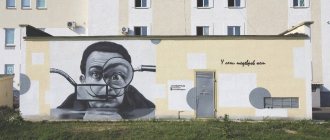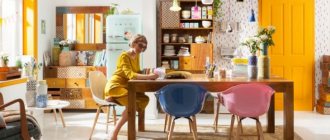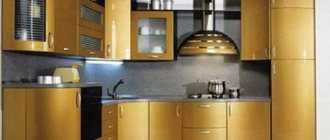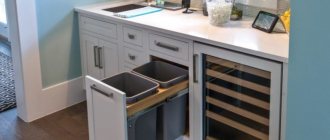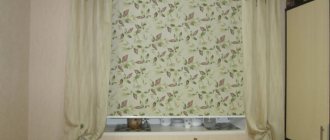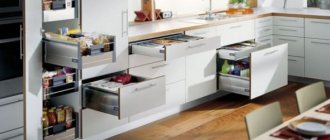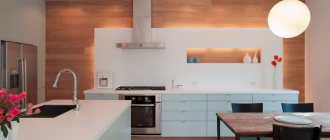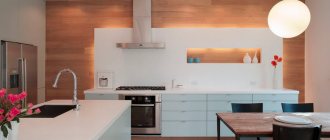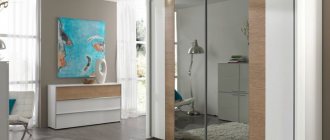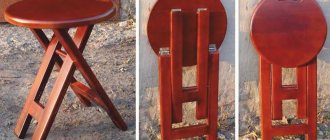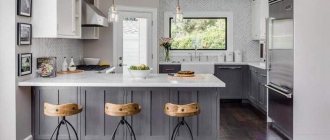Kitchen design
0
3 256
Share
It's no secret that we spend a lot of time in the kitchen, so the interior, style and materials for renovating a room are selected carefully and planned. Modern stores offer a variety of wall decoration options. Among them are wallpaper, plastic, tiles, wood panels, but frescoes on the wall in any interior style give a truly original look. Murals for the kitchen - what are they for? We'll talk about this in today's article.
Frescoes can be matched to any style and this is what is very convenient
- How to use frescoes in the interior
- Advantages
- Types of bases for modern frescoes
- How to choose frescoes to match the style of the kitchen
- Wall mounting
Features of modern frescoes
Fresco is a wall style of painting. To create a unique pattern, the surface is specially prepared, and the pattern is created by hand by the artist. Carrying out such masterpieces requires not only painting skills and inspiration, but also great patience. This is labor-intensive work that requires a lot of time and effort.
Modern manufacturers of finishing materials have not ignored the growing interest of consumers in this decor. Nowadays, in order to create a fresco on the wall in the kitchen or living room, it is not necessary to invite a professional artist. The market's assortment includes self-adhesive materials that everyone can handle.
Anyone can handle self-adhesive frescoes
Those who want to include a fresco in the interior of the kitchen, to ensure its uniqueness, have the opportunity to choose an application technology, on which the aesthetic indicators and image properties depend. The basis can be
- plaster,
- canvas,
- hard surface,
- non-woven wallpaper.
The fresco will provide uniqueness to the kitchen interior
When choosing a type, you need to take into account financial capabilities. Frescoes made on different types of materials differ significantly in price.
Fresco - varieties and their features
The classification of the finishing composition is based on the materials used to create it. The division of finishing also focuses on the method of its manufacture - manual or industrial. As a rule, the fresco is made by hand, which makes it unique and sophisticated. Some types of material use machine methods, due to which the effect of antiquity and exclusivity is lost. Each type has its own advantages and can decorate certain areas of the kitchen. Types of fresco:
- on a rigid basis;
- on canvas;
- non-woven;
- on flexible plaster;
- self-adhesive.
On canvas
This type of fresco is considered elite. It is not manufactured on a production scale, but is ordered individually for each kitchen. The finishing is created by painstaking manual labor and can take months to create a complete composition. The birthplace of fresco on canvas is Italy. The following materials are used to create the composition:
- lime;
- adhesives;
- cotton canvas;
- sand;
- dyes.
Elite fresco on canvas
The production technique is very complex: the selected image is subjected to artificial aging and only then, using the specified materials, is transferred to canvas. The resulting composition is glued to the area of interest in the kitchen using ordinary glue, like wallpaper.
The image is covered with protective layers, but it remains sensitive to various types of damage. Therefore, it is recommended to place this decor away from the active kitchen area. The fresco literally “screams” about its exclusivity, so the overall decor should match it.
Self-adhesive
A budget-friendly type of finishing material, which is distinguished by a simple method of pasting and an equally simple appearance. The quality of the image cannot be compared to models on canvas. The material can be used on any surface – paint, plaster, wallpaper. The fresco has a fairly small thickness, so masking the unevenness of the wall is excluded.
Budget solution - fresco made from self-adhesive film
The main material of the composition is crushed sand. It covers the prepared synthetic base, and digital equipment transfers the design to the “canvas”. The variety of images is not impressive. However, such models can be ordered individually, designing a landscape of any complexity.
By using such frescoes you decorate your kitchen in an original way, but you shouldn’t count on the handmade effect. It is also recommended to place the composition away from the cooking area.
Non-woven
A wall fresco for a kitchen of this type is created by applying special plaster to a non-woven fabric. Here additional effects and original areas of the picture can be created. Next, the master draws the details of the composition, giving it a non-standard shade.
Fresco on non-woven fabric
The finishing material is easy to install, very resistant to kitchen “hazards” and can decorate almost any area of the room. The frescoes are characterized by realistic images and durability in use. This type is the most successful in the price-quality category.
On a rigid basis
Handmade, which is created on a special basis. The image can be used as a painting or mounted on a wall. This type of material can be applied directly to prepared blocks on the wall and created live.
Handmade murals are created live
The brightness and color of the work will amaze not only household members, but also their guests. The fresco is used as a bright accent in the design of the room. Size and contrast are determined by the customer.
On flexible plaster
By far the most popular type of fresco today. The main component of the material is plastic plaster, which is complemented by a thin mounting mesh. The design is created using dyes that are based on natural ingredients.
The model has an appearance as close as possible to ancient frescoes. Its surface is expressive and textured. Special foam is used for the installation process. After installation, the edges of the fresco must be treated with plaster. The model looks equally advantageous both as a solo decorative element and as a supporting element of the interior.
Fresco on flexible plaster is a practical and durable option
The finish is practical and impressively thick. If you plan to cover the entire wall with it, then you can forget about additional masking of unevenness. These models are not afraid of washing and cleaning. Any dirt can be easily removed with a damp cloth without harming the image itself. Fresco on flexible plaster is, without a doubt, the most practical and durable option for decorating a kitchen.
The undeniable advantages of traditional fresco
The classic method of wall painting is in high demand among lovers of refined, prestigious interiors. The charm of such a fresco is undeniable. The surface of the wall is plastered with relief material. Then it is painted in the desired tone for the background. An image is created on it. The painting uses durable paints from natural ingredients. Photos of frescoes in the kitchen made using this technology allow you to see the incredible attractiveness of this decor.
Fresco in the kitchen in a modern interior
Despite the fact that this method is considered classic, it is slightly different from what was used in ancient times, in the Middle Ages. Nowadays, innovative technology developed by Italian masters is used to create frescoes. To strengthen the plaster layer, a reinforcing metal mesh is used. The compositions of the mixtures include fillers that provide the material with increased elasticity. Frescoes created using this method:
- perfectly imitate ancient works of artists;
- are resistant to moisture;
- do not fade in direct sunlight;
- retain their original appearance for many years.
Frescoes can retain their original appearance for many years
A significant advantage of this technology is the affordable cost of work. There are no restrictions on the subject of drawings. It is possible to choose an option based on the features of the interior and its style. The decor is environmentally friendly; only natural materials are used in its creation.
Advantages
The finishing material of the frescoes adds several more advantages to the original and natural look of the paintings:
- frescoes do not fade or fade over time:
- long service life;
- the ability to depict three-dimensional paintings;
- resistance to moisture and temperature changes (except for cheap samples);
- the ability to complete an individual order for transferring an image from a painting or photograph.
You can make any drawing, real craftsmen will do their job
Unique fresco on canvas
The technology of frescoes on canvas has long been used in luxury interiors. Craftsmen prepare and level the surface of the wall, the artist manually creates an image, artificially ages it, giving the appearance of a fresco made several centuries ago. This decor perfectly decorates the room and gives it a majestic, antique look. But the cost of custom-made work is high, affordable for a narrow circle of consumers.
It is possible to purchase a ready-made finishing option. The photo catalog of kitchen frescoes presents works created in Italy and Spain. Modern production includes several stages. A solution of lime powder and fine sand is distributed on the canvas. After the base has dried, the artist creates an image using natural paints. Then abrasions are created, giving the appearance of an antique fresco.
The fresco perfectly decorates the kitchen in any style
Finishing using ready-made canvas will not cause any particular difficulties:
- A reliable adhesive designed for heavy wallpaper is applied to the wall surface;
- the canvas with the fresco is fixed;
- the image is treated with a protective composition based on wax.
This decor cannot be washed, but it is highly resistant to external influences and retains its original beauty for a long time.
Four options for arranging frescoes
Each of the options described below is good in its own way, but not all of them are suitable for DIY installation, although it all depends on your skills.
Option number 1. Timeless classics
From the school course we know that a classical fresco is a pictorial picture painted on wet plaster. This technology allows you to maintain the brightness of colors and resistance to external influences for decades.
Rural landscapes are calming.
According to official sources, the art of painting frescoes appeared in 1500 BC. According to researchers, the oldest fresco is located on the island of Santorini, although similar paintings have also been found in Egyptian pyramids. Therefore, the exact date of creation of the first such painting is unknown to man.
A picture with an open window is an excellent solution for a small kitchen.
Such technology is not available to the common man; moreover, not every artist is able to paint such a panel according to all the rules, because special natural-based paints are used for this, plus you need to work very quickly until the plaster dries.
Complex painting taking into account the ceiling looks impressive.
The price for arranging a real classical fresco is exorbitant and such work takes quite a lot of time, depending on the amount of work it can take from a couple of weeks to several months.
Arrangement of a real classical fresco is a long and painstaking work.
Option number 2. Painting on canvas
In part, this technology is reminiscent of painting, but before applying the image, such a canvas undergoes a long preparation, as a result of which a very thin layer of plaster appears on the canvas, and paint is then applied to this layer.
It is not advisable to place a picture above the sink.
Such paintings are also considered original, but with the current development of technology they have already learned how to reproduce them, although even a copy costs quite a lot of money. Most often you can find artificially aged canvases. But this product is very “capricious”, it requires care and is not suitable for extreme kitchen conditions.
A canvas fresco is not suitable for every kitchen.
Option number 3. Self-adhesive
This type of painting can be safely called consumer goods. This fresco can be applied to the wall with your own hands in half a day, and for this you only need a glue brush and a roller. This technology is very similar to applying transfers, which many of us glued to the refrigerator or school desk as children.
The river against the background of the forest visually increases the space.
You shouldn’t expect any sky-high, impeccable quality from such panels. In a kitchen, this transfer will last a maximum of 3–4 years, plus even the new picture shows traces of its artificial origin.
Wildlife is considered a win-win option when arranging any room.
Option number 4. Frescoes on wallpaper
This option is best suited for self-development. The basis here is non-woven or fiberglass textured fabrics. Such wallpaper, of course, cannot be called cheap, but compared to natural painted frescoes, this is an excellent solution, and I will tell you how to do it correctly in the next chapter.
Painting the upper level of the kitchen is considered a good solution.
Fresco on non-woven wallpaper
Many consumers have already appreciated the benefits of non-woven wallpaper. One of the advantages of these materials is the excellent leveling of the wall and the elimination of any minor defects. They are an excellent basis for frescoes. A thin layer of plaster is applied to the surface, on which the image is created.
Using this technology, murals on the kitchen wall can traditionally be created by hand by artists. But there is a more economical way. Nowadays, specialists have professional printers in their arsenal that can transfer any desired image onto the base. This way:
- provides an unlimited selection of drawings and paintings;
- guarantees high transfer accuracy and color saturation;
- saves costs on creating decor.
Any image can be transferred to a non-woven base.
Frescoes created on a non-woven base can be artificially aged. For this purpose, special impregnation is used. Its application to the image creates a network of tiny cracks. The fresco perfectly imitates the work of ancient masters.
We decorate the kitchen personally
After choosing the type of fresco suitable for the dining area, it must be mounted on the wall or ceiling. You can do this yourself, but it is recommended to contact specialists. Difficulties with installation are kept to a minimum, however, delicate moments in the form of joining the panels should be entrusted to a professional. Otherwise, you risk ruining the plot.
You can fix the fresco on the surface yourself
Personal installation algorithm:
- preparation of walls - cleaning them, eliminating errors, priming;
- preliminary placement of the fresco in order to choose the correct placement angle and height;
- gluing the image using special glue (depending on the type of fresco);
- removing excess glue with a roller.
It is worth noting that when decorating a kitchen with frescoes, it is necessary to avoid the slightest drafts. Otherwise, the composition may not stick well.
Fresco window will expand the kitchen space
Heavy murals and self-adhesive materials
There is a special type of frescoes that have high artistic value. These images are thick and heavy, and have special chips on their edges. It is difficult for a non-professional to distinguish such works from frescoes preserved from ancient times. These expensive decorations require a rigid base that can withstand heavy loads.
The most affordable option for those who want to use frescoes in the interior of the kitchen without high costs are semi-finished products on a self-adhesive basis. Such materials are also produced by Italian and Spanish brands. The disadvantages of this decor include:
Ready-made frescoes will decorate the kitchen interior without high costs
- the need to carefully prepare the base, since all the smallest flaws will be noticeable;
- there is no antiquity effect in these images;
- the drawing is created digitally and is not unique.
However, in this category you can find the perfect interior decoration. Photo catalogs of kitchen frescoes contain many interesting, beautiful images in various themes.
How to use frescoes in the interior
Designers often use murals to decorate the kitchen, but the artistic element can also be used from a practical point of view:
- to make the room visually appear higher, painting in light shades with a reflective effect is applied to the ceiling;
- decorative plaster in the interior can be used as a border between the working and dining areas;
- For small kitchens, windows with landscapes are painted to add a feeling of spaciousness.
- frescoes on a rigid base hide unevenness and defects of the walls.
Advantages of decor, its specifics
The growing popularity of this type of decor is due to its obvious advantages. Fresco:
- is a unique decoration, gives the interior individuality;
- has high strength, will retain its beauty in difficult kitchen conditions;
- can be created on any type of surface;
- environmentally friendly;
- can be used in any interior style;
- retains its original appearance for a long time.
Frescoes can be created on any type of surface
Numerous photos of frescoes in the kitchen posted on Internet sites make it possible to verify the attractiveness of such interior elements. You can choose an option for both a spacious and a small room. The sizes of images created manually are selected taking into account the available space.
Advantages of using it in the interior
The advantages of frescoes over ordinary photo wallpapers and simply painted patterns are obvious:
- frescoes are more durable. The colors do not lose their brightness for a long time and do not fade in the sun;
- they do not require updating or special care;
- you can choose an image to match any color and style of the room;
- they look expensive, original and unusual, surprising all guests.
Photo: lushome.com
Frescoes in designer styles
Particularly popular are artificially aged frescoes that imitate ancient painting. Therefore, there was an opinion that this decor is only appropriate in classic designs. Indeed, on websites you can see many photos of interiors with a fresco in the kitchen in classic and antique styles. But you shouldn’t limit the scope of application of this decor so much. Thanks to innovative technologies for creating wall decorations, this finish can be used in any design, even ultra-modern ones.
Unlimited possibilities in choosing the subject of images allow you to find an interesting solution, taking into account the nature of the situation, the atmosphere that needs to be created in the kitchen. The interior may appear:
- ancient ruins, famous landmarks;
- medieval castles and palaces;
- romantic motifs of the Renaissance;
- wonderful natural landscapes;
- urban panoramas;
- celebrity portraits; world map, etc.
The theme of the fresco is selected taking into account the nature of the situation
When choosing an image for a fresco on the wall in the kitchen, you need to focus on the main shades and other types of finishes. In this case, the design will be harmonious, and the unique decor will appear in all its glory and become a worthy decoration of the interior.
Fresco - features and characteristics
Before we get into practical advice on how to implement a design, let’s understand the terminology. Kitchen murals are historical or contemporary images that cover the surface of a flat or relief structure. The finished finishing material is a picture located on the ceiling or wall of the room.
The use of frescoes has become popular due to the creation of a special atmosphere. The finishing method transports household members to a mesmerizing Provençal meadow or the Cote d'Azur of the ocean. If you complement the kitchen with decorative items characteristic of the image (slopes, window openings, antique furniture, candelabra), then a solid composition will be formed, captivating with its originality.
Frescoes fit harmoniously into any interior
Murals for the kitchen are the latest development, which allows the use of various types and textures of material. Thanks to this, the final image can be flat or three-dimensional. With the help of modern tricks, an already magnificent drawing can acquire the missing liveliness and naturalness.
Wall painting in classical styles
Classic styles are often chosen to decorate kitchens. They give the room a sophisticated, elegant look. The popularity of these trends practically does not depend on changes in fashion; you can not change the situation for many years, it will meet the standards.
Photos of frescoes in the interiors of kitchens in a classical style are widely presented on the Internet. There are many options for such designs. They differ in character and theme:
- imitation of antique painting will provide grandeur and pomp;
- natural landscapes add comfort;
- Renaissance style images create a romantic atmosphere;
- city panoramas add a touch of sophistication.
Natural landscapes create a comfortable atmosphere
This decor is great for Provence and country. These designs are cozy and warm. They look harmonious with village and garden landscapes, fields with sunflowers and lavender. In Provence you can create views of the sea coast. These interiors often use various still lifes and imitations of brickwork.
The city panorama will add a touch of sophistication
The fresco will be an ideal decoration for any ethnic style. Eastern destinations are especially popular now. Blooming cherry blossoms, bamboo, and a pagoda will look great in a Japanese or Chinese interior. You can choose a fashionable African style for the kitchen, decorate it with pictures of the jungle or savannah. Frescoes on the wall in the kitchen will help support the chosen direction and make it more expressive.
Modern decoration with frescoes
Modern technologies make it possible to create any image by hand painting or by printing. This decor can be used in high-tech and minimalism, loft and art deco, industrial and fusion. It is easy to choose paintings that correspond to these areas of subject matter. In the photo of murals for the kitchen in modern styles you can see:
- portraits in pop art style;
- cityscapes;
- three-dimensional graphics;
- compositions of geometric shapes;
- technical drawings;
- mechanisms, etc.
Fresco in the kitchen in a modern style
Such images become the highlight of the interior and provide it with uniqueness. Full compliance with the theme and design canons guarantees impeccable harmony.
How to choose frescoes to match the style of the kitchen
Frescoes in the kitchen interior turn an ordinary room into a unique and cozy corner. Moreover, the technology of drawings allows you to create miniature inserts and paintings the width of the wall, but when choosing a painting, consider the following selection rules:
- decorative paintings should visually increase the size of the kitchen;
- for small rooms do not use wall-sized panels; it is better to choose a small drawing as a decorative insert;
- the painting is selected in accordance with the style of the room.
To make photo wallpapers and frescoes on the wall in the kitchen interior look harmonious, let’s consider some styles of room decoration and which images are suitable for painting.
Classic
Classic style is popular for the kitchen. The basis is played by the even shapes of furniture, stucco, high-quality and expensive materials, so frescoes and photo wallpapers in the interior only complement the style of the room.
Wall painting in the interior is done in the Renaissance style, mosaics, antique motifs, paintings by Italian or French artists.
If you choose the type of drawing, then textured plaster corresponds to the classic style of the kitchen and other rooms.
Each style has its own approach and design
High-tech and minimalism
Modern styles include clear, rough lines, rich dark tones, so kitchen wall painting is done in bright colors and using computer graphics. Complex mechanisms, abstractions, mosaics or three-dimensional images of geometric shapes are suitable for drawing.
Artistic plaster or self-adhesive will be suitable if the budget does not allow extra costs.
Country and Provence
These two styles most naturally convey the coziness and comfort of a home atmosphere, which is why they are often used for modern kitchens.
Use landscapes or architecture so that the interpretation of the drawing complements the style of the room.
Ethnic
Ethnic style reflects the atmosphere of other countries and peoples in your home.
A fresco in an ethnic-style kitchen should naturally be part of the overall design concept
The interior of the room turns out to be unusually bright and attractive thanks to decorative inserts or patterns, so frescoes complement the ethnic style of any direction well. So, the kitchen is decorated:
- Oriental style includes Japanese or Chinese elements in the interior. Landscapes, sakura flowers, cranes, bamboo or peonies are suitable for painting.
- The African style supports savannah landscapes, images of animals and local life in vibrant colors.
- Egyptian style is often used for kitchens. It creates a warm atmosphere in the room thanks to its sandy color scheme and attracts attention with characteristic patterns, for example for a work wall. Pyramids, hieroglyphs, ancient drawings, statues and gold inserts on a sand base are suitable for drawings.
Placing frescoes in the kitchen interior
The kitchen has a specific interior. Traditionally, one of the walls is occupied by a set with a work area. It is impossible to place a full image on it. This decor is a presentable decoration, it is necessary to show all its advantages. The best option is to place the fresco in the kitchen on a wall that is not occupied by other objects. You should not install furniture that blocks the image, this can spoil the impression and will not allow you to present the drawing in all its glory.
The fresco is created on a wall free from furniture
It is advisable to create a fresco in the interior for a large kitchen. This decor requires space. However, it is possible to decorate a small room with a unique image. If there is no free wall for painting, the fresco can become an apron located in the work area. There are types of decor that are not scary:
- moisture,
- steam,
- high temperatures,
- drops of fat.
Their surfaces are cleaned of any contaminants. A fresco apron will be an effective decoration for a small kitchen, making it original and attractive. The theme for the image is selected in accordance with the specifics of the interior. These can be dishes that stimulate appetite, berries and fruits, flower arrangements, etc.
An apron-fresco will become a spectacular decoration
A good option for a small kitchen are small fresco inserts. They can be placed on any wall. Photos of interiors with frescoes in the kitchen will help you choose the right theme to create the right atmosphere. You can apply beautiful landscapes and still lifes to furniture facades.
Choosing a plot
Usually the traditional image on the fresco is a still life of flowers, fruits and vegetables, which evokes the appetite.
Photo: albertolamaphotography.com
Another common option is a city view, which designers combine with the style and colors of the kitchen.
Photo: vanhoef.com
Bulky images will not look good in a small kitchen. We advise you to opt for three-dimensional pictures that will visually complement the room.
Photo: ecoohotnadzor31.ru
Creating a fresco with your own hands
Homeowners who have artistic skills and excellent taste do not have to hire artists or purchase ready-made images. They can create murals on the kitchen wall with their own hands. Consumables for this decor can be found in specialized stores. Hand painting will require a lot of effort and time, but the result deserves such efforts. An image made according to your own creative idea will be unique; well-chosen themes and a palette of shades will allow the painting to fit harmoniously into a specific interior.
You can decorate the environment with original decor without having the talent of an artist. You need to look at photos of frescoes in the kitchen interior on the Internet, choose a simple image option, or make a sketch yourself. After this you can start working. To create a fresco you need:
- qualitatively level the surface;
- apply plaster, cover it with primer;
- create the desired background;
- on the reverse side, paint over the sketch with a stylus;
- attach a sheet to the wall to make a mark;
- if you need to draw lines;
- color the drawing;
- After the paints have dried, cover the painting with wax or varnish.
You can decorate an interior with a fresco without having the talent of an artist
Of course, in this way it is unlikely to be possible to create an image similar to those that flaunt on designer photos of frescoes in the kitchen. But if you apply diligence and patience, and do the work carefully, a worthy decoration will appear in the interior. High quality modern paints and the presence of a protective layer will ensure the preservation of the image for several years.
Ready-made frescoes and stencils
If you have no artistic skills, but photos of interiors with a fresco in the kitchen aroused a strong desire to create the same decoration, you can use methods available to everyone.
Modern styles do not often use complex landscapes and panoramas. Minimalism, loft, hi-tech can be decorated with compositions of geometric shapes and various mechanisms. To create such drawings, you can use stencils, which do not require special skills to work with. If it’s difficult to come up with a design yourself, you can look at photos of murals in the kitchen in modern styles.
You can use stencils to create paintings on the walls.
Stencils are made of thick cardboard and coated paper. The leveled, plastered surface is covered with a background shade. When applying stencil designs, a foam sponge or brush is used. The dried image must be covered with a protective layer.
You can handle finished frescoes and wallpaper yourself. The wall needs:
- plaster
- prime,
- polish,
- cover with a thin layer of putty.
Every user can handle sticking a finished fresco
The gluing process uses a composition intended for non-woven wallpaper. If you choose a ready-made Spanish or Italian fresco for the kitchen in a photo catalog of famous brands, glue for fixing it on the wall is sold along with it. Every user can handle this job. It is important to act carefully and first apply markings for the exact location of materials. Excess glue protruding beyond the edges must be removed immediately. The adhesive composition is applied to the base.
